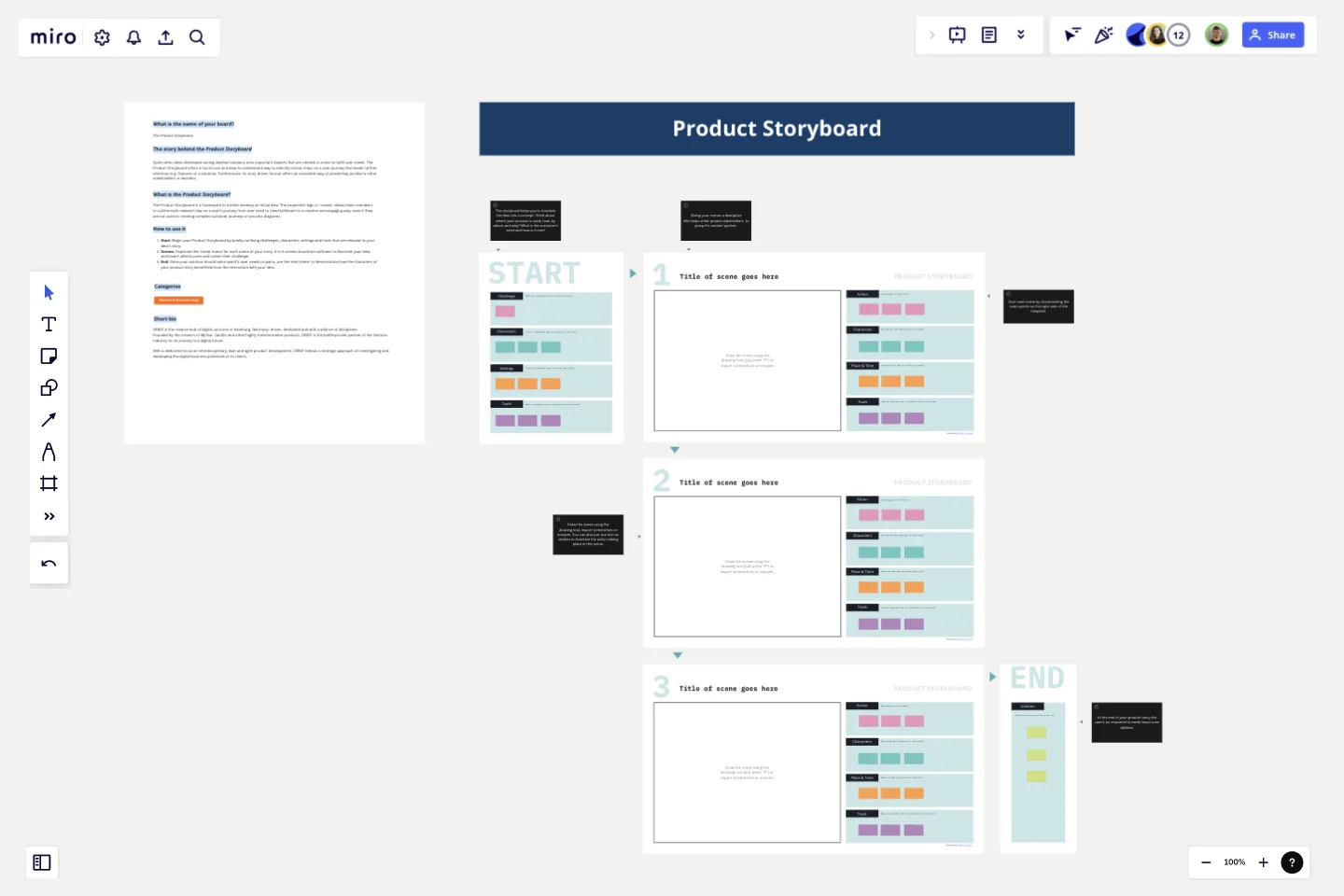The Product Storyboard
Quite often ideas developed during ideation sessions miss important aspects that are needed in order to fulfill user needs.
The story behind the Product Storyboard
The Product Storyboard offers a fun-to-use and ease-to-understand way to identify certain steps on a user journey that needs further attention (e.g. features of a solution). Furthermore, it's story-driven format offers an accessible way of presenting an idea to other stakeholders or deciders.
What is the Product Storyboard?
The Product Storyboard is a framework to further develop an initial idea. The sequential logic in 'scenes' allows team members to outline each relevant step on a user's journey from user need to need fulfilment in a creative and engaging way, even if they are not used to creating complex customer journeys or process diagrams.
How to use it
Start: Begin your Product Storyboard by briefly outlining challenges, characters, settings and tools that are relevant to your idea's story.
Scenes: Duplicate the 'scene frame' for each scene of your story. 3 to 6 scenes should be sufficient to illustrate your idea and how it affects users and solves their challenge.
End: Since your solution should solve specific user needs or pains, use the 'end frame' to demonstrate how the characters of your product story benefitted from the interaction with your idea.
This template was created by Nono Weinzierl. Discover more storyboard template examples and map your next project.
Get started with this template right now.
Product Discovery Kick Off Workshop
Works best for:
Product Managament, Planning
The Product Discovery Kick Off Workshop template accelerates the start of product discovery initiatives. By facilitating collaborative workshops, defining objectives, and establishing timelines, this template ensures that product discovery efforts are structured and focused. With sections for defining user personas, articulating problem statements, and setting success criteria, it guides teams through the initial stages of product discovery, laying the foundation for successful product development. This template serves as a catalyst for aligning teams and kick-starting product innovation journeys.
Backlog Refinement with Jira Template
Works best for:
Agile, Backlog Refinement
The Backlog Refinement with Jira template in Miro improves collaboration among team members. It provides a visual and interactive space for teams to review, prioritize, and clarify upcoming work items together in real time. This collaborative approach ensures alignment on priorities and details, leading to a more organized and efficient workflow. The seamless integration with Jira automatically syncs all changes, reducing the need for manual updates and keeping both platforms up-to-date.
Calendar 2024 - a Year timeline
Works best for:
Strategy, Planning
The Calendar 2024 a year Timeline template is perfect for planning and organizing your year. It helps you schedule important dates, track annual goals, and stay on top of deadlines. This template ensures you have a clear overview of your year ahead.
AI Product Canvas
Works best for:
Product Management, Planning
The AI Product Canvas template facilitates the development of AI-powered products with a comprehensive framework. By defining AI capabilities, data requirements, and ethical considerations, this template guides teams through the AI product development process. With sections for identifying use cases, defining algorithms, and assessing model performance, it ensures that AI solutions meet user needs and ethical standards. This template serves as a strategic guide for developing innovative AI products that deliver value and drive business success.
Async Roadmap Sharing
Works best for:
Roadmaps, Planning, Mapping
Async Roadmap Sharing template facilitates asynchronous collaboration on roadmap planning and execution. By providing a centralized platform for sharing updates, feedback, and insights, teams can ensure alignment and transparency across distributed teams. This template promotes flexibility and inclusivity, allowing team members to contribute to roadmap discussions at their own pace and asynchronously across different time zones.
Meeting Minutes Template
Works best for:
Planning
With Miro's Meeting Minutes Template, capturing the essence of your meetings has never been more efficient and engaging. Stay on top of your projects, foster collaboration, and drive action with this user-friendly tool.
